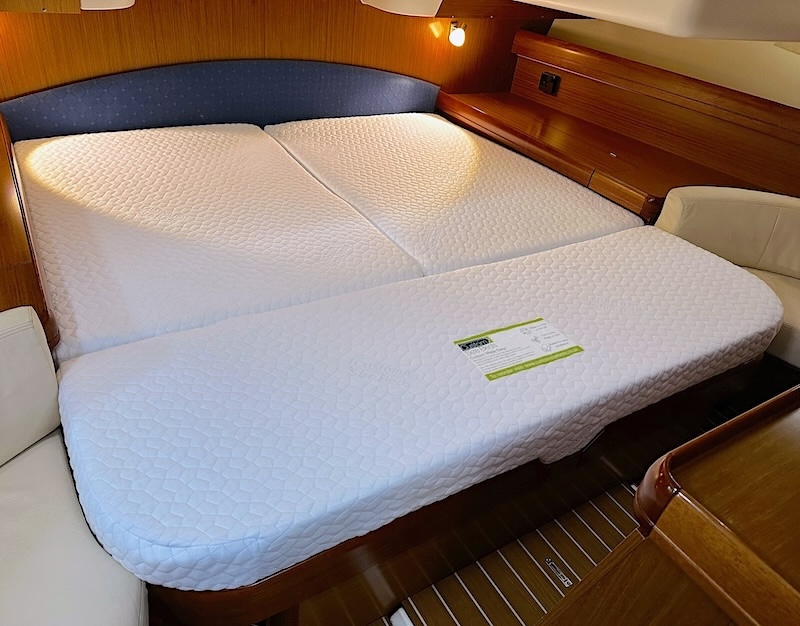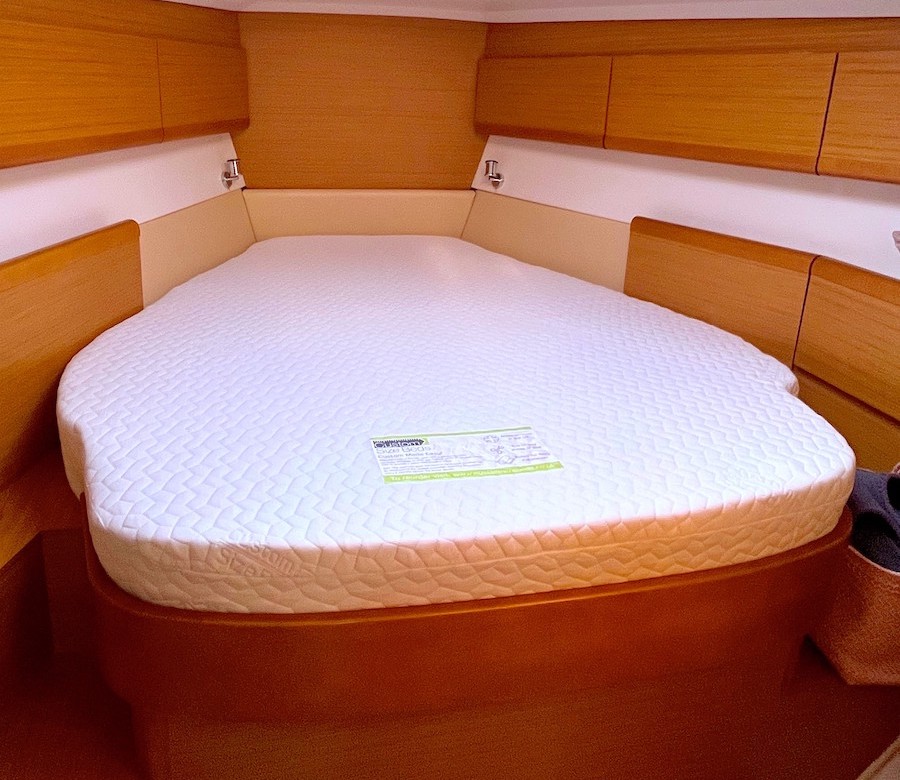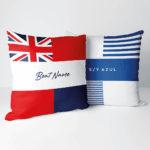Myles Hardy, Director at Custom Size Beds, shares this advice for choosing the mattress for your boat, along with tips for a better sleep onboard.
How does sleep quality differ on a boat versus on land? What unique challenges do boat owners face?
Sleep quality on a boat can be very different. Many standard boat mattresses are made from thin, basic materials that simply aren’t designed for long-term comfort. We use the same high-quality foams and fabrics you’d expect in a good home mattress, which makes a huge difference. One customer told us they’d assumed poor sleep was just part of boat ownership. Within a week, they said they had the best night’s sleep of their life with their new custom size beds and even ordered a regular double for their home made from the same materials.
What’s the most unusual or challenging boat mattress you’ve ever been asked to make?
The most challenging designs are usually the ones that sit right up in the bow of the boat, where the hull curves in sharply and often isn’t symmetrical. Every one of those spaces is unique, so we ask customers to send us a life-size template by post. We cut directly around it in our workshop to make sure the fit is spot-on — no surprises when it arrives.
What are the biggest mistakes boat owners make when choosing or fitting a mattress onboard?
One of the biggest mistakes we see is people trying to make their mattress fit too tightly. Unlike houses, boats rely heavily on airflow – and if a mattress is fitted too snugly, it can trap moisture and lead to condensation. We always recommend leaving a small gap around the edges to help air circulate, and sometimes using an anti-moisture underlay for extra protection.
What feedback do you get from customers after switching from standard to custom-fit boat mattresses?
Customers often tell us they’re amazed at how much better their space feels once they switch to a custom-fit mattress. No awkward overhangs or tight corners – just a design that fits perfectly. Because each mattress is made to order, they can also choose their preferred firmness and comfort level, so it feels just right for them.
What design considerations go into making a comfortable mattress for a narrowboat or yacht?
Designing a comfortable mattress for a boat is all about combining home-level comfort with space efficiency.Yachts have limited access, irregular shapes, and restricted ventilation, so we tailor each mattress for the specific space – optimising thickness, support, and airflow for a perfect balance of comfort and practicality.

How do you work around tricky shapes like V-berths or curved hulls?
Every boat is different. For complex spaces like V-berths or curved hulls, we often work from a full-size paper template that customers send us. This captures the shape from above and the tapered angles of the cabin walls. We cut directly around that template and digitally record the design so replacements can be made easily in future.
Are marine mattresses made with special materials to combat dampness, condensation, or limited ventilation?
Yes. Airflow is everything onboard. We recommend leaving small gaps around the mattress to prevent condensation and often suggest anti-moisture underlays to improve ventilation. We can also make mattresses with water-resistant fabrics to protect against dampness and keep them fresher for longer.
Have you introduced any innovations to make installation easier in tight spaces?
Absolutely. Every mattress is vacuum-packed for delivery, making it easier to move through narrow doors and stairways. For especially awkward cabins, we can make split or hinged mattresses that join together seamlessly once onboard – no compromise on comfort.
What’s the most creative design solution you’ve implemented for a boat interior?
One of our favourites was for a customer who needed a mattress to curve perfectly around built-in cabinetry and a sloping hull – but also lift up for storage underneath. We created a split, hinged design that followed every curve yet folded neatly when needed. It gave full access to storage without sacrificing comfort or fit.
What are your top tips for getting a good night’s sleep on a boat?
Start with airflow and comfort. Don’t fit your mattress too tightly — leave a small gap for circulation, and consider an anti-moisture underlay. Invest in a high-quality mattress made from the same materials you’d expect at home, and try to keep a consistent bedtime routine to help your body adjust to life on the water.
What should people look for when choosing a mattress for a boat or yacht?
Avoid low-grade foam, which is unfortunately common in many leisure spaces. Look for high-quality materials that match the comfort of a good home mattress, with proper support and ventilation.
How can boat owners reduce dampness, mould, or odour in sleeping areas?
Airflow is crucial. Leave small gaps around the mattress, use an anti-moisture underlay, and air the mattress regularly. Water-resistant fabrics can also act as a barrier to dampness and help keep the space fresher.
How often should a boat mattress be replaced, and why?
Typically every 5–10 years. Over time, foam and fillings lose support – and in a marine environment, humidity and temperature swings can accelerate wear. Dips, lumps, or odours are all signs it’s time for a refresh.
How does weather affect sleep and mattress needs onboard?
Temperature swings are a big factor. Cabins can get hot in summer and cold in winter, so the right materials make all the difference. An AeroFresh® foam, for example, delivers up to 30× more airflow than traditional memory foam – keeping it cool in summer and cosy in winter.
Getting a decent night’s sleep on board a boat isn’t just about firmness – it’s about airflow, fit, and moisture control. Here’s how to make your berth more comfortable and durable.
1. Don’t fit too tightly
It’s tempting to make a new mattress fill every inch of the cabin, but that can trap moisture and cause dampness beneath. Always leave a few centimetres of clearance around the edges for ventilation
2. Improve airflow under the bed base
A simple anti-moisture underlay or ventilated slat system creates a gap for air to circulate and helps prevent condensation, especially on metal or solid bases.
3. Choose marine-grade materials
Look for high-resilience foams and breathable, water-resistant covers. These materials are designed to handle humidity and temperature changes better than standard domestic options.
4. Think ahead about access
If your berth is awkward to reach, consider a split or hinged mattress. It makes fitting (and cleaning) much easier without compromising comfort.
5. Keep it fresh in the off-season
When the boat’s laid up, remove bedding, stand mattresses on edge, or use moisture-absorbing products. Airing out the cabin regularly will extend mattress life and reduce mildew risk.


















